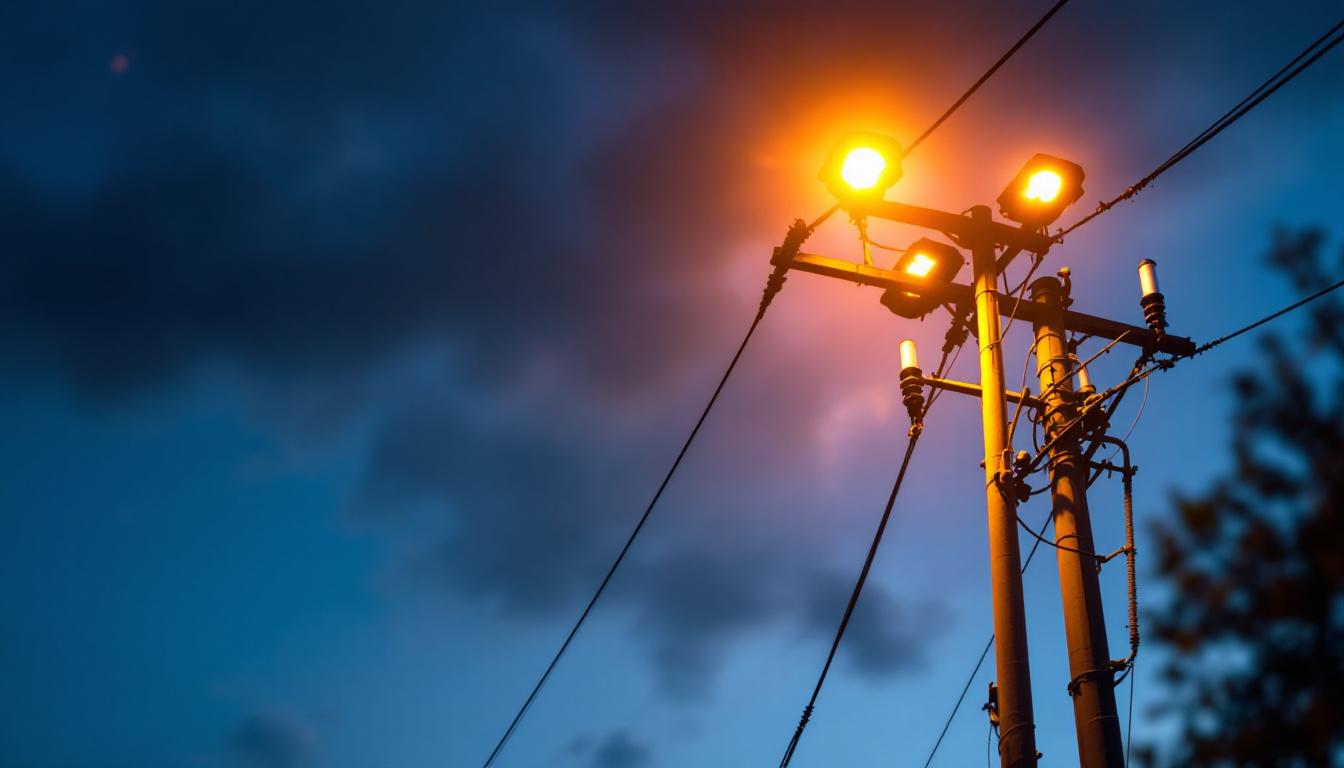
Utility pole lights play a crucial role in providing illumination for streets, parking lots, and other outdoor areas. For lighting contractors, understanding the intricacies of these lighting solutions can enhance project outcomes and client satisfaction. This article addresses common questions that lighting contractors have regarding utility pole lights, covering topics from installation to maintenance.
Utility pole lights are outdoor lighting fixtures mounted on utility poles, designed to illuminate public spaces efficiently. They are typically used in residential neighborhoods, commercial areas, and along roadways to enhance visibility and safety during nighttime. These lights can be powered by electricity or solar energy, offering flexibility depending on the installation environment.
These fixtures come in various designs and technologies, including LED, HID, and fluorescent options. The choice of technology impacts not only the quality of light produced but also energy consumption and maintenance requirements. As such, contractors must be well-versed in the advantages and disadvantages of each type to make informed recommendations to clients. For instance, LED lights are increasingly favored due to their longevity and energy efficiency, often lasting up to 25,000 hours compared to traditional bulbs. This longevity translates into reduced maintenance costs and less frequent replacements, which can be a significant advantage for municipalities and businesses alike.
Utility pole lights serve multiple purposes beyond mere illumination. They enhance safety by reducing the risk of accidents in poorly lit areas, deter criminal activity, and improve the aesthetic appeal of neighborhoods. Proper lighting can also extend the usability of outdoor spaces, allowing for evening activities and increasing foot traffic in commercial areas. In addition, well-lit streets and public parks can encourage social interactions and community gatherings, fostering a vibrant atmosphere that can lead to stronger neighborhood ties.
Moreover, well-lit areas can contribute to community well-being, fostering a sense of security among residents. For contractors, understanding the broader implications of utility pole lighting can help in designing solutions that meet both functional and community needs. The integration of smart lighting technology, which allows for adaptive brightness based on real-time conditions, is becoming a popular trend. This not only enhances energy efficiency but also allows for a more responsive lighting solution that can adapt to varying levels of pedestrian and vehicular traffic, further enhancing safety and comfort in public spaces.
When installing utility pole lights, several factors must be considered to ensure optimal performance and compliance with local regulations. First, the height and spacing of the poles are critical. Proper height ensures that the light reaches the intended area without causing glare or light pollution. Spacing should be calculated based on the type of light used and the desired illumination level. For instance, LED lights may require different spacing compared to traditional incandescent bulbs due to their directional nature and intensity. Understanding the specific lighting needs of the area, such as whether it is a high-traffic zone or a quieter residential street, will help determine the best configuration.
Additionally, contractors must consider the power source. If using electric lights, access to power lines and the capacity of the electrical system must be assessed. For solar-powered lights, the location should receive adequate sunlight throughout the day to ensure sufficient energy storage for nighttime use. It’s also essential to evaluate the potential for future energy needs, especially in areas where urban development is expected. This foresight can help avoid costly upgrades or replacements down the line.
One of the primary challenges in installing utility pole lights is navigating existing infrastructure. Contractors may encounter obstacles such as overhead power lines, trees, or other structures that can impede the installation process. Proper planning and site assessment are essential to identify and mitigate these challenges. This may involve consulting with utility companies to ensure safe distances from power lines or even relocating certain installations to avoid conflicts with existing trees or buildings. Furthermore, understanding the local landscape can help in selecting the most effective pole locations that minimize disruption.
Weather conditions can also affect installation timelines. Rain, snow, or extreme temperatures may delay work, necessitating flexibility in scheduling. Additionally, ensuring compliance with local codes and regulations can be complex and may require obtaining permits or inspections, which can further extend project timelines. Contractors must stay informed about local zoning laws and environmental regulations, as these can vary significantly by region. Engaging with local authorities early in the process can streamline approvals and help anticipate any potential issues that may arise during installation. Moreover, the use of advanced planning software can aid in visualizing the project and identifying potential conflicts before the physical work begins, ultimately saving time and resources.
Regular maintenance is vital for the longevity and effectiveness of utility pole lights. Contractors should recommend a maintenance schedule that includes routine inspections every six months. During these inspections, the physical condition of the poles, fixtures, and wiring should be assessed for wear and damage.
In addition to visual inspections, cleaning the fixtures is essential to maintain optimal light output. Dust, grime, and other debris can accumulate on the lenses, reducing illumination levels. Depending on the environment, cleaning may need to be performed more frequently in areas with high pollution or dust levels.
Several indicators suggest that utility pole lights require maintenance. Flickering lights, dim illumination, or complete outages are clear signs that something is amiss. Contractors should also be vigilant for physical damage to the poles or fixtures, such as rusting or cracks, which could compromise structural integrity.
Additionally, if the light is not illuminating the intended area effectively, it may indicate that the fixture needs repositioning or replacement. Prompt attention to these signs can prevent more significant issues down the line, ensuring that the lighting remains effective and safe.
Energy-efficient lighting solutions, particularly LED technology, have become increasingly popular in utility pole lighting. These fixtures consume significantly less energy than traditional incandescent or HID lights, resulting in lower utility bills for clients. Furthermore, LEDs have a longer lifespan, reducing the frequency of replacements and associated labor costs.
Beyond financial savings, energy-efficient lighting contributes to sustainability efforts. By reducing energy consumption, these solutions help decrease greenhouse gas emissions, aligning with broader environmental goals. Lighting contractors can play a pivotal role in promoting these benefits to clients, highlighting the long-term value of investing in energy-efficient technologies.
Contractors can promote sustainability by educating clients about the advantages of energy-efficient lighting options. Providing case studies or examples of successful projects that utilized such technologies can help illustrate the benefits. Additionally, offering comprehensive energy audits can identify areas where clients can improve efficiency and reduce costs.
Incorporating smart lighting solutions, such as motion sensors or timers, can further enhance energy savings. These technologies allow lights to operate only when needed, minimizing unnecessary energy use. By staying informed about the latest advancements in lighting technology, contractors can offer innovative solutions that align with sustainability goals.
Lighting contractors must navigate various regulations and codes when installing utility pole lights. These regulations can vary by location and may include requirements related to light pollution, energy efficiency standards, and safety protocols. Familiarity with local zoning laws and building codes is essential to ensure compliance and avoid potential fines or project delays.
Additionally, contractors should be aware of any specific regulations pertaining to outdoor lighting, such as those governing the brightness of lights or the use of certain technologies. Engaging with local authorities and attending relevant workshops or seminars can help contractors stay updated on changes in regulations.
To ensure compliance during installation, contractors should develop a thorough understanding of the applicable regulations before commencing work. This includes obtaining necessary permits and conducting pre-installation site assessments to identify any potential compliance issues.
Maintaining clear communication with local authorities can facilitate a smoother installation process. Contractors should document all steps taken to comply with regulations, including any modifications made to the original plan. This documentation can serve as a valuable resource in case of inspections or audits.
The utility pole lighting industry is continually evolving, with innovations aimed at enhancing efficiency, functionality, and user experience. Smart lighting systems, which incorporate IoT technology, are gaining traction. These systems allow for remote monitoring and control, enabling contractors to manage lighting more effectively and respond to issues in real-time.
Additionally, advancements in solar technology are making solar-powered utility pole lights more viable and efficient. Improved battery storage and solar panel designs are increasing the reliability of these systems, making them a more attractive option for contractors and clients alike.
To stay ahead of trends in utility pole lighting, contractors should invest in ongoing education and training. Attending industry conferences, webinars, and workshops can provide valuable insights into emerging technologies and best practices. Networking with other professionals in the field can also foster collaboration and knowledge sharing.
Furthermore, subscribing to industry publications and following relevant online forums can keep contractors informed about the latest developments. By staying proactive and adaptable, contractors can position themselves as leaders in the utility pole lighting market, ready to meet the evolving needs of their clients.
Utility pole lights are an essential component of outdoor lighting solutions, providing safety, security, and aesthetic benefits. For lighting contractors, understanding the nuances of these fixtures—from installation and maintenance to energy efficiency and regulatory compliance—is crucial for delivering successful projects.
By addressing common questions and staying informed about industry trends, contractors can enhance their expertise and better serve their clients. Embracing innovation and sustainability will not only improve project outcomes but also contribute to a brighter, safer future for communities.
Ready to elevate your lighting projects with superior utility pole lights and outdoor lighting solutions? Look no further than LumenWholesale, where we offer an extensive selection of high-quality, spec-grade lighting products at unbeatable wholesale prices. Say goodbye to middleman markups and hello to reliable, high-performance lighting that meets the highest industry standards. With free shipping on bulk orders, you can trust that you’re getting the best value without any hidden fees. Make your next project shine with the perfect blend of quality, affordability, and convenience. Visit LumenWholesale now for Wholesale Lighting at the Best Value.

Discover why sourcing canopy lights in bulk from local distributors might not be the best choice for your business.

Discover how Sylvania Automotive Lighting is revolutionizing energy efficiency in vehicles.

Discover why high bay LED lights are revolutionizing the lighting industry and what every contractor should know to stay ahead.

Discover essential insights for lighting contractors on the versatile Cool Lamp Gooseneck Glass Shade.